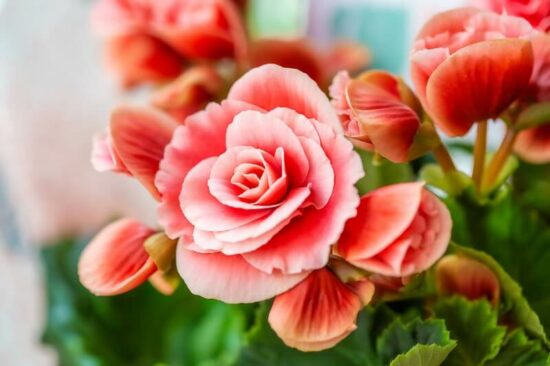Begonias are lovely flowers that many people enjoy planting, but keeping critters away from them can be challenging!
This guide will teach you if deer eat begonias, if begonias are deer resistant, and what you can do to protect these plants.
Table of Contents
Do Deer Eat Begonias?
Many gardeners consider begonias to be a pretty standard part of any summer garden. Classified as an annual in most parts of the country, begonias are prized for the variety of color and texture that they bring to any garden setting. There are around 2,000 species of begonias, so these plants are an excellent option for gardeners who want to add an extra bit of interest to their garden.
If you live in a deer prone area, then you know that even one deer can cause total chaos in your garden. Not only will deer eat a wide variety of vegetables and flowers, but they will also crush other plants under their feet.
Fortunately, deer will usually not eat begonias if they happen to pass through your property.
We are not promising that very hungry and desperate deer won’t give it a shot, but they will almost always look for something else. As long as there are more pleasing options available, you shouldn’t have to worry about your begonias being eaten by deer.
Are Begonias Deer Resistant?
For the most part, begonias are considered to be pretty deer resistant. What does that mean? It means that you can feel quite confident about planting begonias in your garden.
However, the natural world is not cut and dry, and there are some exceptions to this rule.
There are several reasons why deer tend to leave your begonias alone and skip trying to eat them. The first reason is that deer don’t like the smell of begonias. These flowers have a pungent smell that you may not really notice, but any deer raiding your garden will surely be able to.
Second of all, deer can be pretty finicky when it comes to the texture of their food. Many begonia varieties have leaves that are covered in a soft fuzz. While deer may tolerate other odd textures, fuzziness is not one of them.
You can’t really make a one-size-fits-all statement about begonias and their reputation for being deer resistant. Because there are so many varieties of begonias, it’s impossible for them all to have exactly the same leaf texture or scent. This means, unfortunately for many gardeners, that some kinds of begonias are more deer resistant than others.
The Variety Matters
So which types of begonias are considered to be the most deer resistant? Since there are thousands of different begonias, it would be beyond the scope of this article to mention them all. Instead, we will take a look at a few of the most common ones that you may find at your local nursery or home improvement store.
Probably the most well-known deer resistant begonia is the wax begonia. This variety is a very common addition to summer gardens, and it’s a popular option for pots and porch decorating. In the case of wax begonias, it’s not fuzzy leaves that repel deer. Instead, it seems that the very smooth, waxy texture of wax begonia leaves is also something that many deer find unappealing. The strong scent is also something that tends to keep deer away.
Another kind of deer resistant begonia is the dragon wing begonia. This variety is popular with gardeners due to its heat tolerance, its stunning flowers and its relative ease of care. As with the wax begonia mentioned above, the dragon wing begonia has very shiny, smooth leaves. For some reason, the combination of strong smell and very shiny leaves seems to make deer uninterested in eating them.
Other begonias that are known to be fairly deer resistant include rex begonias and tuberous begonias. It’s important to remember when you hear that a plant is deer resistant, it doesn’t mean that it’s deer proof. Like people, different deer have different tastes, so you may find that even your most deer resistant begonias have been given a nibble.
How To Stop Deer From Eating Begonias
No one wants to go through the hard work of planting a garden, only to have deer come along and eat their begonias if they’re desperate. And deer will do more than eat a wide variety of plants, they will trample anything in their path. That’s yet another way they can wreak havoc on your begonias.
What’s a gardener to do? It’s not like it’s possible to keep a watch on the garden 24 hours a day. Luckily, there are a few measures that you can take to try to keep deer away from your begonias. Deer prevention methods range from simple and inexpensive tricks to more drastic measures. When you’re dealing with deer in the garden, time is of the essence, so let’s take a look at some things that you can do to keep deer away from your yard.
Before we get started, we’d like to mention that not all of these methods will work all of the time. Every situation is unique, and a lot depends on your area, weather patterns and the size of the deer population. In some cases, one method may be enough, but we recommend using more than one.
1. Use Companion Planting
Companion planting is a very old gardening technique that involves planting certain plants near each other. Sometimes this is done because the plants benefit each other in some way. In other cases, certain plants are placed together because one attracts devastating insects away from the other.
If you are using companion planting to help with a deer issue, then you are going to want to plant species that are known to be deer resistant near the plants you are trying to protect.
For example, if you want to keep deer from eating your begonias, then you may want to try planting things, such as poppies, daffodils, caladiums, cosmos, and black-eyed Susans nearby. The idea is to make the area around your begonias seem as uninviting as possible by using plants that most deer won’t even touch. Plants with sharp thorns also make good companion plants for begonias.
2. Grab A Bar Of Soap
You might love the fresh, clean scent of a new bar of soap, but deer don’t. You can use this fact to create a simple deer deterrent that uses things you probably already have at home.
Take a new bar of soap, the more strongly scented the better, and poke a few holes in the paper wrapping. Leaving the wrapper on, you’re going to place the bar of soap into a nylon sock or pantyhose. Once the soap is fastened securely in the pantyhose, attach the package to a stick, dowel or garden stake. For the best results, you really should make quite a few of these soap bundles. Place them around the perimeter of your garden, focusing on the areas where your begonias are.
Some people shave the soap and sprinkle the soap shavings around their begonias. This method will release the smell sooner, but the shavings will melt quickly if it rains, or if they get wet when you water your garden.
3. Use A Deer Repellent
There are commercial deer repellent sprays that you can buy, and most of them are thought to be fairly effective. Deer repellents that you find in home improvement stores generally contain some kind of urine. The thought is that deer will smell the urine, think it’s from a predator, and then they’ll find someone else’s garden to raid.
If these sprays don’t appeal to you, you can make your own spray. Mix eight ounces of white vinegar with six drops of peppermint essential oil and four drops of rosemary oil. Place this solution in a spray bottle and spray the area near your plants. It’s worth it to double the batch, so you can spray the whole perimeter of the garden (or just around your begonias).
4. Go Ultrasonic
The use of ultrasonic devices to keep animals away from gardens has been around for some time, but for some reason, this method has never seemed to gain as much popularity as some of the other methods. The claim is that these devices emit irritating, ultrasonic vibrations that only animals can hear. Once you place several of these ultrasonic contraptions around your yard, the deer will be repelled by the unpleasant vibrations.
Do they really work? Some people say they do, and some say that they are not worth the money. This uncertainty may be why this method never really caught on. Our advice is to try using them in combination with another form of deterrent if you’re dead set on stopping deer from eating your begonias.
5. If You Build It, They Won’t Come
If you’ve tried some of the above methods and you’re still having an issue with deer eating or trampling your begonias, then you may want to put up a fence around your garden. We understand that many gardeners find fences to be unsightly, but they really are the only pretty foolproof way to keep deer away from these plants.
There are all kinds of fences to choose from, so there’s no need to build one that detracts from the look of your garden. There are wooden ones, ones made from wire, electric fences and even mesh fencing. Just pick the one that best fits your situation, budget and aesthetic sense.
6. Odds And Ends
There are some more “out there” tricks that you can try. Some of these include spreading human hair around the perimeter of your garden, getting a dog to scare away the deer and to sprinkle urine around the garden. An internet search will most likely pull up some even stranger ones, and maybe some of them are worth a try. It’s up to you.
If all of the methods mentioned above sound like too much work, then you can plant your begonias in pretty pots and put them on your porch. Most deer won’t venture that close to a house.
Conclusion
Deer will eat begonias if they’re very hungry or desperate, but it’s not normally something you need to worry about. Begonias are fairly deer resistant and will often be ignored by these animals.
But if you’re having trouble, now you know what to do!


